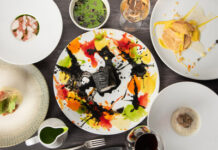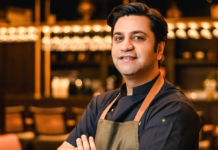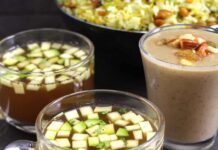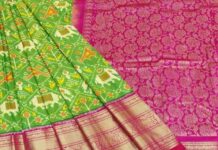 Everything I learned about cooking was made possible by my mother. Working with her I realized that she was able to inculcate in me the same love of experimentation and the love of varied cuisines that she had. The aplomb with which she undertook the strangest food preparations, and the confidence she oozed when asked to make a dish with which she had little familiarity was an exercise in determination. No wonder we both have landed in the soup several times because of this!
Everything I learned about cooking was made possible by my mother. Working with her I realized that she was able to inculcate in me the same love of experimentation and the love of varied cuisines that she had. The aplomb with which she undertook the strangest food preparations, and the confidence she oozed when asked to make a dish with which she had little familiarity was an exercise in determination. No wonder we both have landed in the soup several times because of this!
Amma’s stories are peppered with the misadventures of her forays into the world of cooking after her wedding. Not having a mother to guide her in these more domestic matters since the age of eight, and having grown up in a hostel, her culinary expertise was nil at best. Did that baulk her? Can’t say it did. Neither could her in-laws.
Being all of 20 years old, and lacking guile of any sort, she was instantly welcomed and enveloped with love by my uncle, Babu (20 years my father’s senior), who was more like a grandfather, and Badi amma, his wife, and the five offsprings.
Time with Babu
Every summer my parents traveled to Faizabad to spend time with Babu and extended family. Each summer had its own stash of stories, vying for top honors in their hilarity and absurdity in equal measure.
One summer, there was a bounty of katahal (jackfruit) in the family garden. So, when Babu saw fresh cut katahal hauled into the kitchen from the big old tree, and amma hovering in the background, it was destiny that made him ask for katahal cutlets to be served to his visiting friend, Prabhu Dayal. Having nodded her silent consent for this task, amma set about figuring out what to do with the fruit (vegetable), with a prickly skin and tough-looking interior to turn it into palatable cutlets.
Rummaging through her memory bank, she realized something similar having been cooked at her home. Armed with the faint memories of something that may have resembled katahal cutlets, amma set about making that memory a reality. Summoning thakur (the cook), she asked for besan paste to be prepared for dipping the cutlets, and katahal to be chopped into bite sized pieces.
Thakur, the wise cook refrained from raining on her parade, and assuming that “bahurani” knew what she was doing, obliged with the task. No sooner than that was done, she expertly covered each morsel in the spicy paste and deep fried it, making sure it turned out golden brown. Accompanied with a savory chutney, it looked rather appetizing.
When it was sent out to the drawing room for consumption, it came back soon after, barely touched. At that, amma tried one herself, only to find the cutlet impossible to bite through! In her haste to recreate the appearance of the cutlet, minor details like parboiling the tough flesh before dipping into besan, was overlooked, resulting in undercooked end product!
Not to be deterred, amma continued with her cooking experiments, sending out her creations to the unsuspecting stream of visitors. In those days, the “chulhas” (earthen stoves) were kept going by burning coal, and regulating the heat through fanning, and a complicated system of closing and opening various apertures built into the chulha.
Mind you, those were the days before instruction manuals existed! It was confusing to operate the chulha and trying to remember which apertures had to be closed so as to condense the heat and increase the temperature, as also what maneuvers to perform for the cooling effect.
Amma, being amma had taken on the task of making aate ka halwa (popular dessert made of wheat flour, milk and sugar) for all the kids in the family. Now, halwa is an everyday dessert and veteran cooks can make it without resorting to recipes or instructions, which did not exist in the written form then. So, amma was following her heart and what felt right to make this dessert, while juggling with keeping the fire at the right temperature.
Halwa for friend
Babu sauntered in from the garden, and once again seeing her cook, asked amma to supply some of the halwa for his old friend, the regular visitor, Prabhu Dayal! The halwa making process can be complicated and involves a slow roast of the wheat flour on a steady fire, so it is no longer raw, then simmering it gently in milk, water and sugar so it takes on the right appearance and texture.
She followed most of the steps and left out a few…which happened to include the slow roast of the wheat flour to the right level of doneness, mostly due to the skills needed to keep a steady slow fire.
However, it was an attractive display she put together, garnished with sliced almond, elaichi (cardomom) and chandi ka vark (silver foil). Amma proudly doled it out to the waiting kids and put together a plate to be sent out to the guests. Thakur, meanwhile came to the kitchen to set about making dinner preparations and intercepted the halwa as it was about to be taken to the drawing room.
His experienced nose told him that the wheat flour was still raw!! Amma had to make amends by supplying the kids with digestive tablets so they won’t be taken ill from eating uncooked wheat flour! Luckily, Prabhu Dayal was spared !
Through all this, no one in the family took offence at this pretty young bride who spoke her mind and acted with heart, while committing many a blunder. She earned much love and respect in her new husband’s family and was the favorite bahurani of Babu and Badi amma, the favorite chachi (aunt) of all the nephews and nieces, and the apple of her husband’s eye.
Fast forward to our lives in Calcutta. Always in high gear, with five of us demanding new and varied cuisines, depending on which English novel we were reading at the time. Thus arose the request for spaghetti from my brother, having read about it and watched it in the English movies we went to on Sundays at the Globe theater in Chowringhee.
We searched the fancier New Market and brought home a packet and boiled it with great anticipation and enjoyment of the process. Next was to recreate the red sauce it went with. Having run out of tomatoes, we improvised, and served it with daal (lentil soup), which had been cooked with tomatoes!
This was one mix the taste buds did not find palatable, but we pursued relentlessly to recreate the dish, until the red sauce was made another time, and we enjoyed a home cooked Italian meal in those days. True to her nature, amma embraced these adventures into nouvelle cuisine from foreign lands as much as refining her now polished skills of “desi” food.
Legendry cook
Amma evolved into a legendary cook, with ingredient combinations she thought up, even when no one else was using them quite the same way…also leading to many disagreements between her and me, the novice in nouvelle cuisine experimentation. I would grudgingly admit later that the new combinations “weren’t all that bad”, the closest I came to giving her a compliment.
The first public appreciation I, as a teenager, conceded for her cooking was when my group of school friends at our shared lunches exclaimed over the chatpate chhole (spicy chickpeas) dish. As the five school friends hailed from five different regions of India, our daily lunchtime feasts were a lesson in national integration itself. So, the North Indian chhole, zeere ke aloo (potatoes cooked with cumin), variety of stuffed parathas (layered wheat crepes) and other lunch appropriate dishes were always in demand.
Things became interesting when my non-Indian friends came for dinner and consumed platefuls of spicy chicken, rajma (kidney beans), koftas, biryani and katahal! Sometimes, these binges were followed by an equally voracious consumption of dahi vadas (fried, lentil pancakes soaked in cooling yogurt) in an attempt to cool the impact of the fiery cuisine.
In particular, my French friend, Herve, prompted a troubled look and a whispered caution to me from amma to warn him against further consumption, out of fear for his gastronomic health! However, he didn’t seem none too worse for wear, and even came back seeking more and even more spicy cuisine. So, friends from home and foreign lands became enamored by my mother’s cooking, and fully appreciative of the love and care that went into creating these delightful morsels.
I must add that amma’s stories of her earlier, less than stellar brushes in the kitchen, remain a source of mirth at many a family gathering, while providing inspiration to the budding cooks.
When amma became a mother-in-law and mentor to my elder cousin’s bride who also lived in Calcutta, she amended much of what was not right in her cooking in a way that made bhabhi a really good cook too! I think we can assume that not too many 20 year old brides in those days had much familiarity with pots, pans and spices!
With time and amma’s loving coaching, my sister and I, along with assorted relatives learned how to fluff the besan batter just right to make soft pakoras for making kadhi, or mix the daal batter for dahi vadas. We also figured out the right number of “whistles” to account for the perfect doneness for pressure-cooked dishes, and played a guessing game to predict the number that would be right.
In her last US visit at my brother’s house in Washington D.C when she came to get me married, amma would supervise the perfect meal, simply by following her nose for the right aromas.
Already too sick to cook by now, she would issue suggestions to “add water now”, “smells roasted”, or “turn off the heat now”, even through the pain of cancer she endured. Thanks to some of those first hand experiences, my Austrian bhabhi too has been known for cooking a rather formidable Indian style mutton dish!
Trying new things
My mother’s sheer enjoyment in life’s small details and her love of seeing new places and trying new things has been a source of great joy and laughter to all of us. Her determination to tackle any situation with quiet strength and fortitude served her well in life, especially when she courageously faced her disease. In the end the cancer overwhelmed her frail body, but it could never extinguish the spirit, which continues through our love of the many things she cherished.
Archana Asthana






